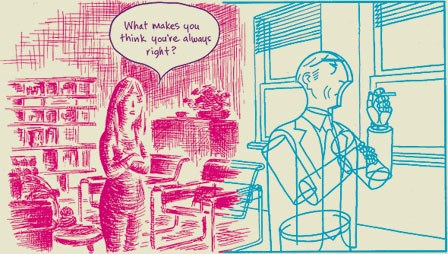Asterios Polyp
Reading Asterios Polyp is a daunting experience. Or maybe not so much the reading, which can be accomplished easily enough, but the being able to speak sensibly about it afterward. I feel kind of like I did after finishing 2666, only not quite so out of my depth. Like Bolaño, Mazzucchelli's work here displays a breadth and depth that overtly requires multiple readings in order to find ground solid enough to speak with any authority about the book.
But since I've only read the book once, you'll have to be satisfied with my initial thoughts. Asterios Polyp is, in the simplest terms, a coming-of-age story—one in which the fifty-year-old lead, celebrated architect Asterios Polyp, begins a quest to put away the childish things of his past and embarks on a journey of both self-discovery and exploration of the world as it is rather than how he has for so many years determined to see it. In this aspect, Asterios reminded me of Mr. Ryder from Ishiguro's The Unconsoled, a man at the top of his rarefied field who still must learn to grow up. And like Ryder, Asterios suffers from an inability to see the world as it is and is (really, like us all) victim to his own perceptions.

Reality, perception, and memory play a huge role in Mazzucchelli's work here even as they do in everything I've yet read by Ishiguro.
On top of this is layered the framework of Greek tragedy with specific allusion to the myth of Orpheus (this is pointed out through fistfuls of overt clues, not the least of which is a dream in which Asterios takes the role of Orpheus and his ex-wife Hana embodies Eurydice). We get narrative explanations from a meta-source in the Greek choral tradition. Comparisons to Dionysus and Apollo lead to an evaluation of dualistic systems (and perhaps systems generally) as Asterios gradually must free himself from systemic shackles in order to finally grow up. Of course we suspect if Asterios abandons one aspect he will be destroyed even as Orpheus was for abandoning Dionysus. As well, there are plenty of references to The Odyssey and readers will find this cross-pollination of mythologies only serves to enrich the experience of Asterios' journey.
The subject matter, by its summary, sounds simple enough but Mazzucchelli throws so much into this piece and exercises such deft control over the page that one can easily drown in the details. The art is very particular. Much is made of Mazzucchelli's use of colour through the book and, well, with good reason. The colouring itself offers storytelling that is available through no other means. In fact, so occasionally powerful is his use of colour that I worry for colourblind readers, that they might miss out on some of the book's more sublime moments.

On top of Mazzucchelli's tight reign over his colour spectrum, there is ample evidence that he maintains the same level of control over his linework and design. Asterios Polyp is a thoroughly designed experience, with every element from script to story to illustration to panel design to colouration to control of whitespace adding voice to the chorus of this performance. The battle between geometric and organic shapes gives readers (who may not be familiar with all the names and ideas Asterios or his ghostly narrator references) a hook on which to hang their interpreter's hat. One's experience of Asterios Polyp will no doubt be more enriched by a working knowledge of architectural history, familiarity with Greek mythology and Homeric tradition, and a smackerel of understanding of postmodern sculpture—but Mazzucchelli's conveyance of story through his visual sense means that even those with Asterios-sized gaps in their education can still get in there and have some deeper sense of what's going on.

As of this writing, I have only read Asterios Polyp once. Of course I still have questions. Of course I do. I think I understand the ending, but I'd like to reread and think on it again. I think I understand why he physically takes on the identity of his true last name in the book's final act (Polyp is only half his original surname, as the immigration official chopped in half the family name when his father immigrated to America). I sometimes understand what Mazzuchelli intends with his character names and sometimes not. I have the barest kernel of an idea why Mazzuchelli, in a mature work that depicts nudity and violence, insists on representing verbal obscenity with cartoony symbolic representation (e.g. "We made up a $#@*load of these"). I don't yet fully grasp Asterios' Ignazio dreams. I am certain, however, that many of these things will become more clear on subsequent readings.
As I said, I have only read Asterios Polyp once. And I can't wait to change that fact.
Good Ok Bad features reviews of comics, graphic novels, manga, et cetera using a rare and auspicious three-star rating system. Point systems are notoriously fiddly, so here it's been pared down to three simple possibilities:
3 Stars = Good
2 Stars = Ok
1 Star = Bad
I am Seth T. Hahne and these are my reviews.
Browse Reviews By
Other Features
- Best Books of the Year:
- Top 50 of 2024
- Top 50 of 2023
- Top 100 of 2020-22
- Top 75 of 2019
- Top 50 of 2018
- Top 75 of 2017
- Top 75 of 2016
- Top 75 of 2015
- Top 75 of 2014
- Top 35 of 2013
- Top 25 of 2012
- Top 10 of 2011
- Popular Sections:
- All-Time Top 500
- All the Boardgames I've Played
- All the Anime Series I've Seen
- All the Animated Films I've Seen
- Top 75 by Female Creators
- Kids Recommendations
- What I Read: A Reading Log
- Other Features:
- Bookclub Study Guides










